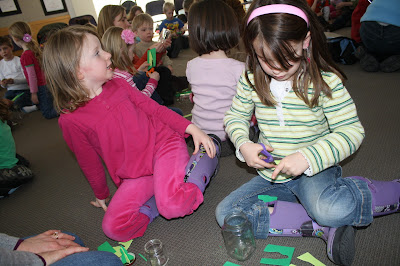Last Friday I had the pleasure of crafting with some great teens. Needle felting is a simple accessible craft, if you can poke a needle you can needle felt. Only two of the participants were experienced needle-felters but everyone was very successful.
Hedgehogs are surprisingly popular in our northern porcupine country. Their shape makes them the perfect beginner project. I've been needle-felting lots of critters for my new book project Stitched Whimsy. In the process I've realized the importance of chenille skeletons that form a sturdy flexibility core under the wool roving. In this case the wire allows you to raise and lower the hedgie's nose. The first step is to fold the chenille stem in half and trap a thin pinch of roving in the fold. I use inexpensive wool mill scraps for the foundation of all my felted creations.
Form the chenille stem ends into two loops, twist the wire ends around the base of the loops. Interlock the two loops together to create a framework for the body.
Tightly wrap the roving around the folded chenille stem to create the nose and head. Working over a foam matt or section of rigid foam insulation poke the roving on all sides with a felting needle. A felting needle has tiny barbs that catch the individual wool fibers and knit them together, the more you poke the more the fibers are compressed.
Fill the chenille frame with roving and then over wrap the body with additional base roving. Needle-felt the roving on all sides to compress the fibers and solidify the body.
Cover the base color with brown roving, switch directions as if you were winding a skein of yarn. The combination of overwrapping and needle felting will tighten the body. Wrap the head and nose in beige roving and needle-felt in place.
Roll tiny pinches of colored roving to make the eyes and nose. Needle felt these small pieces directly into the beige head. Spiral slightly larger pinches of beige roving and needle-felt them on the matt/board before felting the bottom edges to either side of the head.
The flower embellishment is made by spiraling a piece of roving into a circle and felting it just behind an ear. Pull strands into the center to form petals. I added a touch of green roving for a small leaf accent.
This lucky critter was given a stylish purple top hat.
As always my projects are open to adaptation, it was fascinating to observe the creation of this weasel.
One of the participents came late and skipped on the chenille stem step she made an adorable mashed potato pair.
So happy our amazing teen librarian was able to leave the desk and join the fun. I was also surprised to have crafty friends join me all the way from Standish.
We had a rare albino hedgehog sighting and a camera shy multi-colored tie dye hedgie.
Don't stop at just one, they're happier in pairs!

























